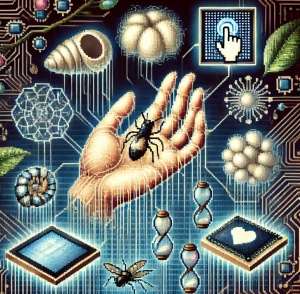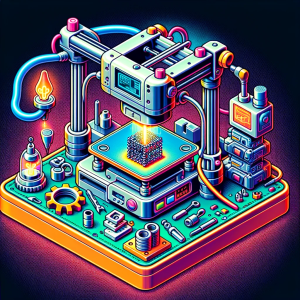
Silk Reinvented: The Next Frontier of Technology
Imagine if your silk shirt or the silk thread in a spider’s web could do more than just look good or be surprisingly strong. What if silk could power electronic devices, bridge the human-machine interface, or even function as sensors for medical diagnostics? It sounds like science fiction, but researchers have recently made a breakthrough, turning this ancient material into something truly revolutionary—a new form of silk that can conduct electronic signals in a whole new way.
How Silk Has Evolved from Fabric to Future-Tech
For thousands of years, silk has been prized for its strength, luster, and versatility. But only in recent decades have scientists begun to unlock its deeper potential. Silk fibroin (SF), a protein in silk, can naturally assemble itself into various structures, like fibrils and films, which exhibit exceptional mechanical and optical qualities. Silk is biocompatible and biodegradable, meaning it can be safely used in medical applications, making it highly valuable in fields like tissue engineering and drug delivery.
This new study takes silk one step further, creating highly ordered 2D silk fibroin films with precise control over its molecular structure. By layering SF films on specific surfaces, scientists have harnessed its potential to create ultra-thin electronic components. This discovery could help propel silk into applications where it interfaces with electronics on a microscopic scale.
Building Silk Layers—One Atom at a Time
What makes this breakthrough truly special is how these silk layers are formed. Imagine each SF molecule arranging itself like bricks in a wall, aligning neatly and precisely. This orderly arrangement happens when SF is introduced to a specific type of smooth, flat surface called a van der Waals (vdW) substrate. Named after a weak molecular force that helps these surfaces attract specific atoms, vdW substrates encourage SF molecules to align, resulting in a perfectly structured, 2D “sheet” of silk.
This new form of silk isn’t just visually neat; it transforms silk into a functional, responsive layer capable of interacting with electronic currents. Researchers found that as the concentration of SF increases, it can create multilayered structures on these vdW substrates, each layer building upon the previous, like stacking multiple delicate, transparent sheets into a thicker, more robust film.
Silk and Its Surprising Journey from Disorder to Order
One of the most exciting aspects of this discovery is the process by which silk fibroin shifts from a disorderly state to a beautifully ordered structure. When researchers apply just the right concentration of SF, the protein molecules transform, settling into a specific, organized pattern on the substrate. This unique alignment happens in two different ways, depending on the concentration:
- Direct Assembly: At low concentrations, SF molecules attach to the surface and immediately arrange themselves into a lamellar, or layered, structure. This is a single, thin layer of SF, almost like a silk crystal lying flat.
- Two-Step Formation: At higher concentrations, the SF starts in a disorderly state. Over time, this chaotic structure reorganizes into an orderly, crystalline form. Think of it like a jumbled pile of puzzle pieces that, with a little guidance, snap into a perfect pattern.
This journey from disordered to ordered is rare for natural materials. For SF, this shift creates an orderly, ultra-thin, two-dimensional layer with potential uses in bioelectronics, where the precision of molecular structure can dramatically influence performance.
Why This Matters: The Dawn of Silk-Based Bioelectronics
The implications of this discovery are profound. For bioelectronics, this breakthrough offers a sustainable, biologically compatible option that could reduce our dependence on traditional, often toxic materials. The potential applications are almost limitless: sensors that interact with the human body without causing harm, biodegradable electronics that won’t pollute our environment, and interfaces that connect seamlessly with biological tissues.
Imagine a world where doctors can monitor vital signs with a silk-based wearable device or even a temporary implant that dissolves when it’s no longer needed. This new silk structure may even serve as the backbone of high-tech medical implants or as part of bio-interfaces that merge biological signals with artificial intelligence.
A New Chapter for Wearables and Health Technology
Wearable technology has grown exponentially in recent years, from fitness trackers to devices that monitor health conditions in real-time. The new SF-based technology could elevate this by allowing devices to be thinner, more flexible, and environmentally friendly. Devices made from SF could even self-dissolve when their job is done, eliminating waste and reducing the environmental footprint of medical wearables.
This kind of integration opens doors to a future where technology is not only more efficient but also truly sustainable. Silk fibroin films could one day be used in patches to measure glucose levels in real time, in wound dressings that report healing progress, or in bio-sensors that monitor various health indicators, offering a real-time glimpse into the body’s inner workings.
Silk’s Potential Beyond Health: Electronics and Beyond
While healthcare is a natural fit for silk bioelectronics, the reach of this technology could extend into other fields, too. Silk films could function in environmentally friendly electronics, where disposable components need to break down harmlessly after use. By customizing these films to control their thickness and electrical properties, researchers can fine-tune them to meet the needs of a range of electronic devices.
Silk films also hold promise for optoelectronics—devices that either detect or control light, such as solar cells or LED screens. By precisely controlling the structure of silk films, we might one day see silk used in eco-friendly, high-efficiency devices that capture or emit light.
What’s Next? From Laboratory to Real-World Impact
Although the applications are promising, moving this discovery from the lab to real-world use will take time and rigorous testing. Scientists will need to refine their techniques to ensure these films remain stable under various conditions and develop ways to mass-produce them reliably.
However, the future looks bright. With continued research, silk could become a core material in the growing field of bioelectronics. This advancement represents not just a leap in technology but a shift in how we think about sustainable, human-friendly materials.
Join the Conversation
- How do you think biodegradable materials like silk could change the world of electronics and healthcare?
- What other natural materials do you believe hold untapped potential for future technologies?
Silk, once known only as a luxurious fabric, is on the cusp of transforming the high-tech world. With each step forward, researchers bring us closer to a future where biology and technology blend seamlessly—creating solutions that aren’t just functional but sustainable and gentle on our planet.
Unlock Science Secrets
Discover revolutionary research and innovative discoveries with ‘This Week in Science’! Designed for educators and science lovers, our free weekly newsletter offers insights that can transform your approach to science. Sign up now and deepen your understanding and passion for science. If you liked this blog, please share it! Your referrals help This Week in Science reach new readers.



